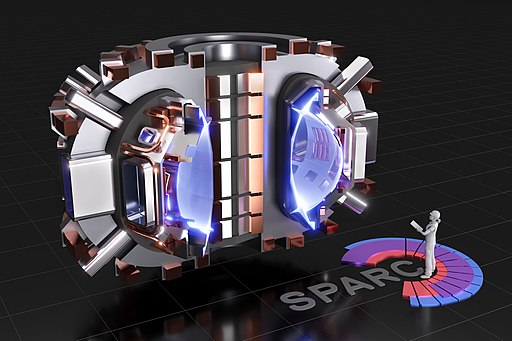Insider Brief
- A new study by a physicist confirms fusion has achieved scientific milestones but there is plenty of work to do before it delivers electricity to the grid.
- The paper outlines a three-stage roadmap — scientific feasibility, engineering feasibility, and economic viability — highlighting critical gaps in laser efficiency, target cost, and reactor durability.
- While private efforts like SPARC and Focused Energy aim to accelerate timelines, public infrastructure and cost-effective integration remain unresolved challenges.
- Image: Steve Jurvetson from Los Altos, USA, CC BY 2.0, via Wikimedia Commons
Understanding the Science Behind Fusion Energy
It’s true fusion power has progressed, moving from theory to demonstration — but when asking how close are we to fusion power actually reaching the grid, the answer is: not quite.
That’s the core message of a study by physicist Stefano Atzeni, published in the journal Rendiconti Lincei. The paper lays out a detailed roadmap showing that while scientific advances have propelled fusion closer to reality, several technological and economic hurdles remain before fusion plants can supply power to the grid.
As background, fusion energy works by fusing atomic nuclei together, releasing energy in the process. Unlike nuclear fission, which splits atoms, fusion produces no long-lived radioactive waste and relies on fuels like deuterium and tritium—forms of hydrogen that are either abundant or producible from lithium. Fusion is often described as “the energy of the Sun,” but making it work on Earth is far more difficult.

Atzeni’s study outlines a three-stage path toward commercial fusion: proving it works scientifically, engineering it to scale, and turning it into a cost-effective source of power.
Stage One: Scientific Feasibility of Fusion Energy
That milestone has been reached — at least in part.
In December 2022, researchers at the National Ignition Facility (NIF) at Lawrence Livermore National Laboratory in California achieved what’s known as “ignition” in a laser-driven fusion experiment. For the first time, the fusion fuel released more energy than was delivered to it.
The experiment used a process called inertial confinement fusion. In this approach, a powerful laser array compresses a small capsule of frozen hydrogen isotopes until it ignites, briefly generating conditions similar to those in the center of a star. According to Atzeni, this marked the first instance of “target gain” — where the energy coming from the fuel exceeded the laser energy delivered to the target.
While the energy output still fell far short of powering anything, the result confirmed the physics. As Atzeni writes that NIF results demonstrate the soundness of two basic elements of ICF, namely compression to high density… and hot spot ignition.
Magnetic fusion, the other leading approach, has not yet achieved breakeven. That method uses powerful magnets to hold a hot plasma in a doughnut-shaped device called a tokamak. The Joint European Torus (JET) experiment in the U.K. holds the current record for magnetic fusion energy release, producing 69 megajoules over five seconds in 2021. But the energy required to sustain the reaction still exceeds the energy produced.
The International Thermonuclear Experimental Reactor (ITER), under construction in France, aims to change that. Its goal is to demonstrate breakeven and then some—producing 10 times more power than it uses for heating the plasma. But ITER won’t begin tritium-fueled operations until at least 2039.
Stage Two: Engineering Challenges on the Road to Fusion Energy
Achieving fusion in the lab is one thing. Turning it into a power plant is entirely another.
To get from ignition to grid, fusion systems must be engineered for continuous, cost-effective operation, according to the study. This involves solving several difficult problems, many of which Atzeni details in his review.
In laser-based inertial fusion, the lasers must fire up to 10 times per second, each time hitting a tiny target precisely. Current laser systems, like NIF’s, were built with 1990s technology and operate at low efficiency. The laser must convert grid electricity into pulses of light with far greater efficiency — at least 10%, compared to the 0.7% currently achieved.
Target manufacturing is another challenge. NIF’s targets are hand-crafted and cost thousands of dollars each. A commercial reactor would need to fire 100,000 or more of these per day, driving the per-target cost down to less than $1. Atzeni writes that future reactors will rely on automated, mass production techniques that are still under development.
Magnetic fusion has its own set of engineering issues. Tokamak systems must deal with extreme heat loads, neutron radiation, and the need to breed tritium inside the reactor. The divertor — the component that removes heat from the plasma — is a particular bottleneck.
The EU’s roadmap for magnetic fusion, as the study summarizes, includes ITER as a physics demonstration, followed by DEMO, a full-scale demonstration plant. DEMO would include all systems needed for continuous power generation, including heat removal, tritium breeding, and integration with the grid. But DEMO is not expected before 2050.
Atzeni writes that many technological aspects are expected to be addressed at this stage, including plasma-facing materials, reactor maintenance schemes, and high-efficiency heating systems.
A facility under construction in Italy, the Divertor Tokamak Test (DTT), will focus on heat management. The EU is also supporting neutron testing facilities to understand how materials degrade under fusion conditions.
Stage Three: Economic Viability and the Future of Fusion Energy
Once engineered, fusion must compete.
Even a functioning fusion energy reactor will be useless if it cannot deliver electricity at a competitive cost, raising the question: how close are we to fusion power becoming commercially viable? This depends on several economic and technical factors, summarized by Atzeni and also reflected in a commercialization checklist compiled from the study.
Among the key metrics:
| Milestone | Status | Comment |
|---|---|---|
| Scientific breakeven (Q > 1) | ✅ ICF | Achieved at NIF |
| Engineering prototype | ⏳ | SPARC by 2027; ITER by 2039 |
| Laser efficiency >10% | ❌ | Currently <1% at NIF |
| Target cost <$1 (IFE) | ❌ | Needs mass production |
| Repetition rate >1 Hz (IFE) | ❌ | Required for power plants |
| Tritium breeding (MFE) | ❌ | Still experimental |
| Reactor materials survivability | ⏳ | Under test at DTT, DONES |
| Pilot plant operation | 🟡 | Focused Energy, SPARC aim for early 2030s |
Private Sector Efforts to Accelerate Fusion Energy Development
Private companies hope to accelerate progress. Commonwealth Fusion Systems is building a compact tokamak called SPARC, using high-temperature superconducting magnets. It aims for breakeven by 2027. Focused Energy, where Atzeni works as a consultant, is pursuing laser-based fusion with a direct-drive design, aiming for a pilot plant within the next decade.
Whether these projects can deliver depends not just on physics, but on systems integration, reliability and cost control. As Atzeni emphasizes, the power plant must not only produce energy, but do so at a cost and scale that fits into existing infrastructure.
How Close Are We To Fusion Power Becoming a Reality?
Fusion is moving from a science experiment to an engineering and manufacturing challenge – but how close are we to fusion power transforming the global energy mix?
The transition is subtle but significant. In the past, fusion conferences were filled with plasma physics and equations. Today, they also include supply chain discussions, target injection systems, and grid integration.
Government support is growing. In the U.S., the Department of Energy has launched programs to support both public and private fusion development, including the Fusion Energy Sciences’ FIRE initiative and support for shared laser facilities through LaserNetUS. Germany has included laser fusion in its federal fusion roadmap.
Still, commercial fusion will not be realized without sustained investment and coordination. As Atzeni notes, “a detailed roadmap for IFE has not yet been defined by public institutions,” though private companies are filling in the gaps.
Rendiconti Lincei is an interdisciplinary scientific journal that publishes articles in physics, chemistry, geosciences, environmental sciences, and biological and biomedical sciences








